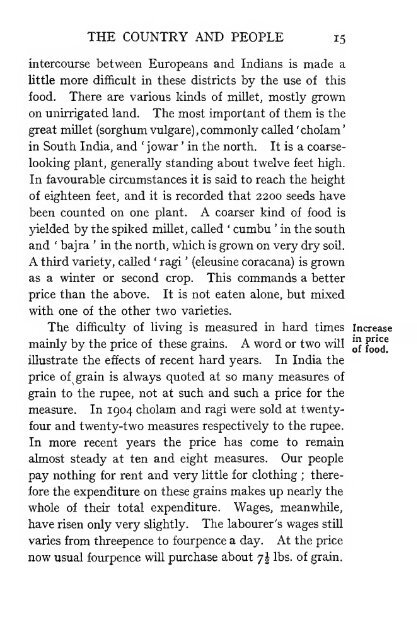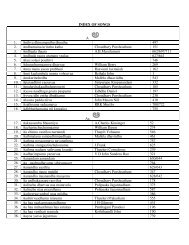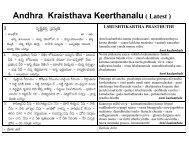Christian missions in the Telugu country - Uecf.net
Christian missions in the Telugu country - Uecf.net
Christian missions in the Telugu country - Uecf.net
Create successful ePaper yourself
Turn your PDF publications into a flip-book with our unique Google optimized e-Paper software.
THE COUNTRY AND PEOPLE 15<br />
<strong>in</strong>tercourse between Europeans and Indians is made a<br />
little more difficult <strong>in</strong> <strong>the</strong>se districts by <strong>the</strong> use of this<br />
food. There are various k<strong>in</strong>ds of millet, mostly grown<br />
on unirrigated land. The most important of <strong>the</strong>m is <strong>the</strong><br />
great millet (sorghum vulgare) , commonly called ' cholam<br />
<strong>in</strong> South India, and ' jowar ' <strong>in</strong> <strong>the</strong> north. It is a coarse-<br />
look<strong>in</strong>g plant, generally stand<strong>in</strong>g about twelve feet high.<br />
In favourable circumstances it is said to reach <strong>the</strong> height<br />
of eighteen feet, and it is recorded that 2200 seeds have<br />
been counted on one plant. A coarser k<strong>in</strong>d of food is<br />
yielded by <strong>the</strong> spiked mUlet, called ' cumbu ' <strong>in</strong> <strong>the</strong> south<br />
and ' bajra ' <strong>in</strong> <strong>the</strong> north, which is grown on very dry soU.<br />
A third variety, called ' ragi ' (eleus<strong>in</strong>e coracana) is grown<br />
as a w<strong>in</strong>ter or second crop. This commands a better<br />
price than <strong>the</strong> above. It is not eaten alone, but mixed<br />
with one of <strong>the</strong> o<strong>the</strong>r two varieties.<br />
The difficulty of liv<strong>in</strong>g is measured <strong>in</strong> hard times Increase<br />
ma<strong>in</strong>ly by <strong>the</strong> price of <strong>the</strong>se gra<strong>in</strong>s. A word or two will JJJ ^J^"<br />
illustrate <strong>the</strong> effects of recent hard years. In India <strong>the</strong><br />
price of ^ gra<strong>in</strong> is always quoted at so many measures of<br />
gra<strong>in</strong> to <strong>the</strong> rupee, not at such and such a price for <strong>the</strong><br />
measure. In 1904 cholam and ragi were sold at twenty-<br />
fom: and twenty-two measures respectively to <strong>the</strong> rupee.<br />
In more recent years <strong>the</strong> price has come to rema<strong>in</strong><br />
almost steady at ten and eight measures. Our people<br />
pay noth<strong>in</strong>g for rent and very little for cloth<strong>in</strong>g ;<br />
<strong>the</strong>re-<br />
fore <strong>the</strong> expenditure on <strong>the</strong>se gra<strong>in</strong>s makes up nearly <strong>the</strong><br />
whole of <strong>the</strong>ir total expenditure. Wages, meanwhile,<br />
have risen only very slightly. The labourer's wages still<br />
varies from threepence to fourpence a day. At <strong>the</strong> price<br />
now usual fourpence will purchase about 7^ lbs. of gra<strong>in</strong>.




